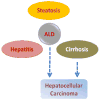Oxidative stress and redox signaling mechanisms of alcoholic liver disease: updated experimental and clinical evidence
- PMID: 22356308
- PMCID: PMC3297983
- DOI: 10.1111/j.1751-2980.2011.00569.x
Oxidative stress and redox signaling mechanisms of alcoholic liver disease: updated experimental and clinical evidence
Abstract
Alcoholic liver disease (ALD) is a major cause of morbidity and mortality in the United States and Europe. The spectrum of ALD ranges from fatty liver to alcoholic hepatitis and cirrhosis, which may eventually lead to hepatocellular carcinoma. In developed countries as well as developing nations, ALD is a major cause of end-stage liver disease that requires liver transplantation. The most effective therapy for ALD is alcohol abstinence; however, for individuals with severe ALD and those in whom alcohol abstinence is not achievable, targeted therapies are absolutely necessary. In this context, advances of our understanding of the pathophysiology of ALD over the past two decades have contributed to the development of therapeutic modalities (e.g., pentoxifylline and corticosteroids) for the disease although the efficacy of the available treatments remains limited. This article is intended to succinctly review the recent experimental and clinical findings of the involvement of oxidative stress and redox signaling in the pathophysiology of ALD and the development of mechanistically based antioxidant modalities targeting oxidative stress and redox signaling mechanisms. The biochemical and cellular sources of reactive oxygen and nitrogen species (ROS/RNS) and dysregulated redox signaling pathways associated with alcohol consumption are particularly discussed to provide insight into the molecular basis of hepatic cell dysfunction and destruction as well as tissue remodeling underlying ALD.
© 2012 The Authors. Journal of Digestive Diseases © 2012 Chinese Medical Association Shanghai Branch, Chinese Society of Gastroenterology, Renji Hospital Affiliated to Shanghai Jiaotong University School of Medicine and Blackwell Publishing Asia Pty Ltd.
Figures




References
-
- Rehm J, Mathers C, Popova S, Thavorncharoensap M, Teerawattananon Y, Patra J. Global burden of disease and injury and economic cost attributable to alcohol use and alcohol-use disorders. Lancet. 2009;373:2223–33. - PubMed
-
- O’Shea RS, Dasarathy S, McCullough AJ. Alcoholic liver disease. Am J Gastroenterol. 2010;105:14–32. quiz 3. - PubMed
-
- Altamirano J, Bataller R. Alcoholic liver disease: pathogenesis and new targets for therapy. Nat Rev Gastroenterol Hepatol. 2011;8:491–501. - PubMed
-
- Lieber CS. Ethanol metabolism, cirrhosis and alcoholism. Clin Chim Acta. 1997;257:59–84. - PubMed
Publication types
MeSH terms
Substances
Grants and funding
LinkOut - more resources
Full Text Sources
Miscellaneous

